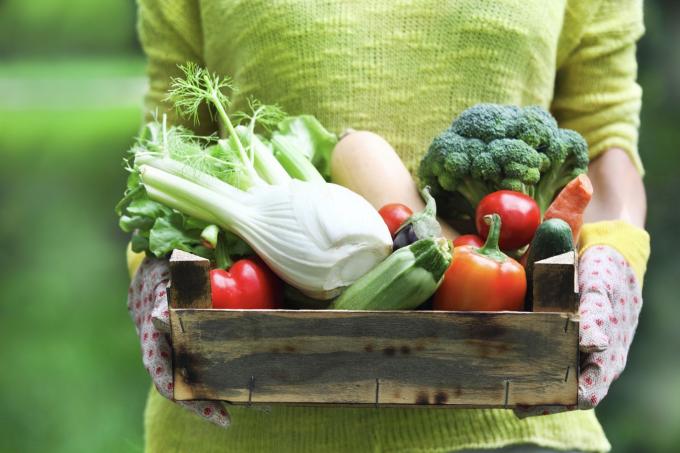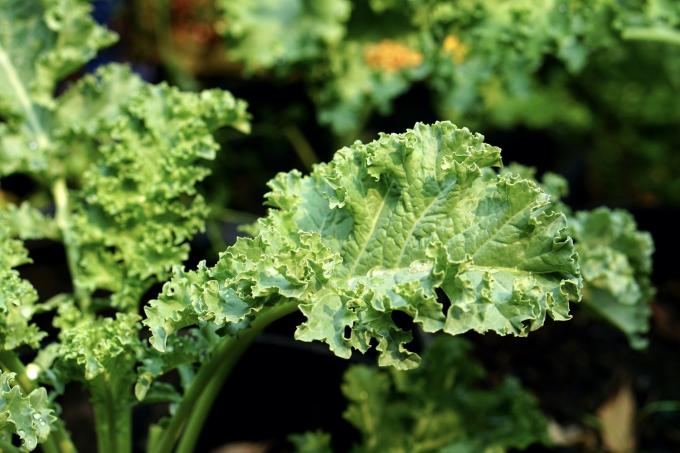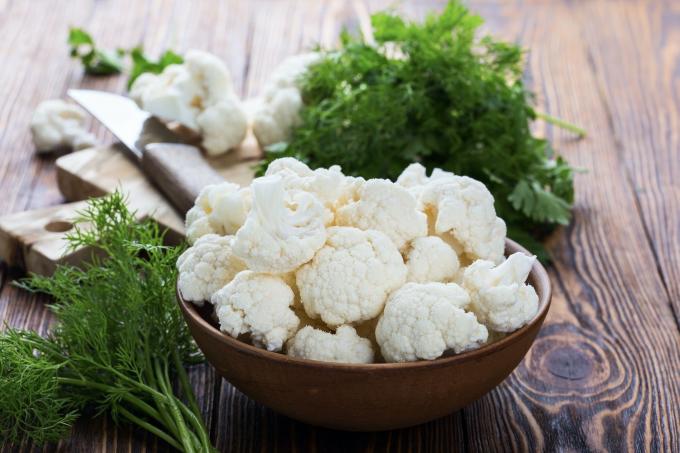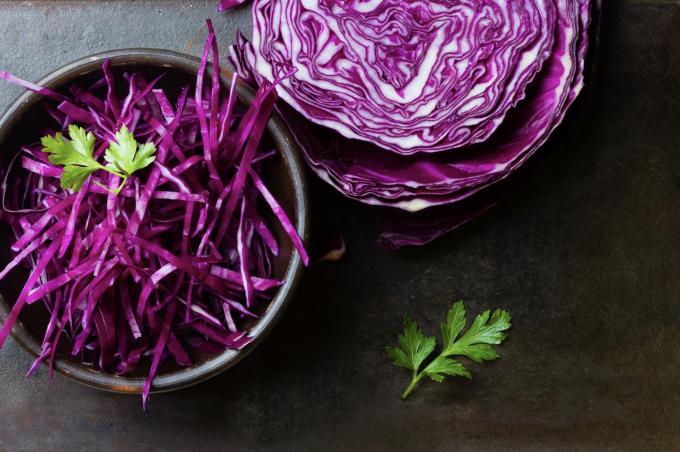A sufficient vitamin C supply for the body is essential - herbs and vegetables with a lot of vitamin C are therefore particularly healthy. But which vegetables have the most vitamin C?

Vitamin C is one of the most important nutrients in our body, because as a radical scavenger it not only protects our cells, but is also involved in the development of connective tissue. However, the immune-boosting effect of vitamin C is particularly well known, which is why many people pay attention to a good supply of vitamin C, especially in winter. Fruit with a lot of the healthy vitamin is often used - but did you know that there are also numerous herbs and vegetables with a lot of vitamin C? In fact, some vegetables even beat oranges and lemons for their vitamin C content. With a content of 50 mg or 53 mg per 100 g of fruit, this is not as high as many think.
"Contents"
- 1. nettle
- 2. parsley
- 3. wild garlic
- 4. paprika
- 5. horseradish
- 6. Brussels sprouts
- 7. Kale
- 8. broccoli
- 9. fennel
- 10. cauliflower
- 11. Kohlrabi
- 12. arugula
- 13. Red cabbage
- 14. spinach
- 15. savoy
Tip: Since vitamin C is sensitive to heat, vitamin-rich vegetables are best eaten raw. To keep the vitamin C content as high as possible, you can alternatively blanch the vegetables carefully.
1. nettle
were valid for a long time nettles (Urtica) as an unwanted guest in the garden. Today, on the other hand, we know that nettles can not only be used as a medicinal plant, but are also wonderfully suited for consumption in the kitchen. The stinging nettle not only scores with its taste, but especially with its inner values - up to 333 mg of vitamin C are contained in 100 g of stinging nettles - that's more than six times as much as in oranges or lemons. The stinging nettle is not only the local vegetable with the most vitamin C, but also convinces with a high content of magnesium, calcium and vitamin A.

2. parsley
The parsley (Petroselinum crispum) is a real all-rounder: Not only does it apply Cultivation of parsley relatively easy, their spicy taste also gives many dishes that certain something. In addition, parsley is also extremely healthy - there are around 160 mg of vitamin C in 100 g of the green herb. Garnishing your meals with parsley is not only an eye-catcher, but also an extra portion of vitamin C.
3. wild garlic
Fresh wild garlic (Allium ursinum) is a real treat and is therefore appreciated by many. But did you also know that wild garlic is a vegetable with a lot of vitamin C? In fact, the plant contains up to 150 mg of vitamin C per 100 g and is therefore ideally suited as a vitamin C supplier. If you don't plant wild garlic in your own garden, you can also collect it in some places in the forest in spring. But beware: it exists Risk of confusion between wild garlic, the poisonous lily of the valley and the poisonous autumn crocus.
4. paprika
When you think of a vegetable with a lot of vitamin C, something immediately springs to mind: peppers (capsicum). With a vitamin C content of up to 140 mg per 100 g, the fruits of the peppers actually belong to the vitamin C-rich vegetables. However, the vitamin C content of peppers is strongly related to their degree of ripeness. For this reason, a fully ripe red pepper has significantly more vitamin C than its green comrades.

5. horseradish
Spicy food is known to be healthy. For horseradish (Armoracia rusticana) this wisdom is justified: 100 g of the hot vegetable contain up to 114 mg of vitamin C. Especially in the cold season, horseradish is not only a culinary change, but can also benefit our health. After all, the vegetables not only have a lot of vitamin C, but also a high content of mustard oils, which have an antimicrobial effect and support the body with minor infections.
6. Brussels sprouts
Cabbage greens are generally considered to be very vitamin C-rich vegetables. Brussels sprouts (Brassica oleracea var. gemifera) is no exception here. On the contrary: With 110 mg per 100 g, Brussels sprouts even lead in terms of vitamin C content. In addition, Brussels sprouts contain folic acid, which is important for blood formation and cell growth, and its secondary plant substances even increase the immune system's resistance.
Tip: The quality of vegetables, the taste and the content of vitamins, minerals and secondary plant substances are largely determined by the nutrient supply of the plant. Anyone who grows their own vegetables should therefore ensure that their plants are supplied with sufficient nutrients using a good fertilizer, for example the Plantura organic tomato and vegetable fertilizer, respect, think highly of. You can find out exactly how to proceed when fertilizing vegetables and what needs to be considered in our article on the vegetable fertilization.

Plantura Organic Tomato & Vegetable Fertilizer
Highly effective organic liquid fertilizer
with an NK ratio of 4-5
for all types of vegetables & berries,
safe for pets and garden animals
7. Kale
Kale (Brassica oleracea var. sabellica) is known and loved as a classic winter vegetable. But not only its late harvest time and its hearty taste make the vegetable a successful meal in the Winter - also due to the high vitamin C content of the vegetable, the kale proves to be a good supplement in the winter Kitchen. In addition to 110 mg of vitamin C per 100 g, kale also impresses with its high protein content and as a good source of potassium, magnesium and iron.

tip: Further iron-rich vegetables can be found in our overview.
8. broccoli
Even if not all children like it – broccoli is good for your health (Brassica oleracea var. italiana) is definitely a good choice. Broccoli is particularly rich in carotene, vitamin B and potassium, calcium and phosphorus. But the green vegetable also impresses with a lot of vitamin C: 95 mg of the immune-boosting nutrient are hidden in 100 g of raw broccoli.
9. fennel
Fennel has long been known not only as a vegetable, but also as a medicinal plant: the essential oils it contains have a particularly positive effect on gastrointestinal complaints. But the high vitamin C content in vegetables also helps the tuber to its reputation as a health plant, because with 93 mg per 100 g it is one of the vegetables richest in vitamin C.
10. cauliflower
Cauliflower (Brassica oleracea var. botrytis) is not only delicious, but also very healthy. The vegetables contain around 69 mg vitamin C per 100 g and are therefore ideal for supporting the immune system. In addition, cauliflower is an important supplier of vitamin B, folic acid and numerous minerals.

11. Kohlrabi
Who Kohlrabi (Brassica oleracea var. gongylodes) enjoys raw food, has chosen a healthy snack for in between. The delicious cabbage contains around 62 mg of vitamin C per 100 g, making it a good source of energy. In addition, kohlrabi not only contains a lot of vitamin C, but is also considered a good source of potassium, calcium and magnesium.
12. arugula
Rucola also has 62 mg of vitamin C per 100 g (Eruca sativa). Especially when the spicy plant is eaten raw in a salad, it is an ideal source of vitamin C. In addition, arugula has a high mustard oil content, which not only triggers the slightly spicy taste, but also supports the immune system in the event of minor infections. Rocket is therefore a valuable ingredient in the kitchen, especially in winter.
13. Red cabbage
Red cabbage (Brassica oleracea convar. capitata var. rubra) a guarantee. But the purple cabbage is not only popular because of its appearance or its aroma, it also shines with excellent nutritional values: the vegetable has a total of 57 mg of vitamin C per 100 g. In addition, red cabbage is an excellent supplier of vitamin E and anthocyanins, which act as antioxidants in the body.

14. spinach
A common misconception is that spinach (Spinacia oleracea) has a very high iron content. Unfortunately, this fairy tale has not come true - in fact, spinach has little more iron than many other vegetables. However, spinach can boast a high vitamin C content: almost 50 mg of vitamin C are hidden in 100 g of the green vegetable. Spinach does not necessarily strengthen our muscles, but it definitely strengthens our immune system.
15. savoy
With around 50 mg vitamin C per 100 g, savoy cabbage (Brassica oleracea convar. capitata var. sabauda) is still one of the vegetables with a lot of vitamin C, but brings up the rear among the coals. Nevertheless, one should not underestimate the savoy cabbage: in addition to vitamin C, the tasty vegetable also contains a lot of protein - and in about twice the amount of, for example, red cabbage. Savoy cabbage also brings iron and phosphorus into our diet in large portions.
Of course, not only vegetables are a good supplier of vitamin C. Fruit types with a high vitamin C content can be found in our article "Fruit with a lot of vitamin C“.
...and receive concentrated plant knowledge and inspiration directly in your e-mail inbox every Sunday!



